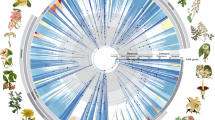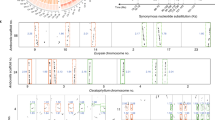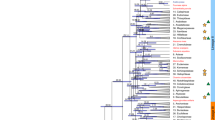Abstract
Angiosperms have dominated the Earth's vegetation since the mid-Cretaceous (90 million years ago)1, providing much of our food, fibre, medicine and timber, yet their origin and early evolution have remained enigmatic for over a century2,3,4,5,6,7,8. One part of the enigma lies in the difficulty of identifying the earliest angiosperms; the other involves the uncertainty regarding the sister group of angiosperms among extant and fossil gymnosperms. Here we report a phylogenetic analysis of DNA sequences of five mitochondrial, plastid and nuclear genes (total aligned length 8,733 base pairs), from all basal angiosperm and gymnosperm lineages (105 species, 103 genera and 63 families). Our study demonstrates that Amborella, Nymphaeales and Illiciales-Trimeniaceae-Austrobaileya represent the first stage of angiosperm evolution, with Amborella being sister to all other angiosperms. We also show that Gnetales are related to the conifers and are not sister to the angiosperms, thus refuting the Anthophyte Hypothesis1. These results have far-reaching implications for our understanding of diversification, adaptation, genome evolution and development of the angiosperms.
This is a preview of subscription content, access via your institution
Access options
Subscribe to this journal
Receive 51 print issues and online access
$199.00 per year
only $3.90 per issue
Buy this article
- Purchase on SpringerLink
- Instant access to full article PDF
Prices may be subject to local taxes which are calculated during checkout


Similar content being viewed by others
References
Crane,P. R., Friis,E. M. & Pedersen,K. R. The origin and early diversification of angiosperms. Nature 374, 27–33 (1995).
Darwin,C. in More Letters of Charles Darwin: A Record of His Work in a Series of Hitherto Unpublished Letters Vol. 2 (eds Darwin, F. & Seward, A. C.) 20–22, 26–27 (John Murray, London, 1903).
Arber,E. A. N. & Parkin,J. On the origin of angiosperms. Bot. J. Linnean Soc. 38, 29–80 (1907).
von Wettstein,R. R. Handbuck der Systematischen Botanik. II. Band (Franz Deuticke, Wien, 1907).
Takhtajan,A. Flowering Plants: Origin and Dispersal (Oliver and Boyd, Edinburgh, 1969).
Doyle,J. A. Origin of angiosperms. Annu. Rev. Ecol. Syst. 9, 365–392 (1978).
Endress,P. K. Reproductive structures and phylogenetic significance of extant primitive angiosperms. Pl. Syst. Evol. 152, 1–28 (1986).
Cronquist,A. The Evolution and Classification of Flowering Plants 2nd edn (The New York Botanical Garden, New York, 1988).
Donoghue,M. J. & Doyle,J. A. in Evolution, Systematics, and Fossil History of the Hamamelidae Vol. 1 (eds Crane, P. R. & Blackmore, S.) 17–45 (Clarendon, Oxford, 1989).
Doyle,J. A. Cretaceous angiosperm pollen of the Atlantic Coastal Plain and its evolutionary significance. J. Arnold Arbor. 50, 1–35 (1969).
Walker,J. W. & Walker,A. G. Ultrastructure of lower Cretaceous angiosperm pollen and the origin and early evolution of flowering plants. Ann. Missouri Bot. Gard. 71, 464–521 (1984).
Friis,E. M., Pedersen,K. R. & Crane,P. R. Angiosperm floral structures from the Early Cretaceous of Portugal. Pl. Syst. Evol. (Suppl.) 8, 31–49 (1994).
Friis,E. M., Pedersen,K. R. & Crane,P. R. Early angiosperm diversification: the diversity of pollen associated with angiosperm reproductive structures in Early Cretaceous floras from Portugal. Ann. Missouri Bot. Gard. 86, 259–296 (1999).
Walker,J. W., Brenner,G. J. & Walker,A. G. Winteraceous pollen in the lower Cretaceous of Israel: early evidence of a magnolialean angiosperm family. Science 220, 1273–1275 (1983).
Taylor,D. W. & Hickey,L. J. An Aptian plant with attached leaves and flowers: implications for angiosperm origin. Science 247, 702–704 (1990).
Sun,G., Dilcher,D. L., Zheng,S. & Zhou,Z. In search of the first flower: a Jurassic angiosperm, Archaefructus, from Northeast China. Science 282, 1692–1695 (1998).
Martin,P. G. & Dowd,J. M. Studies of angiosperm phylogeny using protein sequences. Ann. Missouri Bot. Gard. 78, 296–337 (1991).
Hamby,R. K. & Zimmer,E. A. in Molecular Systematics of Plants (eds Soltis, P. S., Soltis, D. E. & Doyle, J. J.) 50–91 (Chapman and Hall, New York, 1992).
Soltis,D. E. et al. Angiosperm phylogeny inferred from 18S ribosomal DNA sequences. Ann. Missouri Bot. Gard. 84, 1–49 (1997).
Chase,M. W. et al. Phylogenetics of seed plants: an analysis of nucleotide sequences from the plastid gene rbcL. Ann. Missouri Bot. Gard. 80, 528–580 (1993).
Qiu,Y.-L., Chase,M. W., Les,D. H. & Parks,C. R. Molecular phylogenetics of the Magnoliidae: cladistic analyses of nucleotide sequences of the plastid gene rbcL. Ann. Missouri Bot. Gard. 80, 587–606 (1993).
Hillis,D. M. Inferring complex phylogenies. Nature 383, 130–131 (1996).
Graybeal,A. Is it better to add taxa or characters to a difficult phylogenetic problem? Syst. Biol. 47, 9–17 (1998).
Soltis,D. E. et al. Inferring complex phylogenies using parsimony: an empirical approach using three large DNA data sets for angiosperms. Syst. Biol. 47, 32–42 (1998).
Qiu,Y.-L. & Palmer,J. D. Phylogeny of early land plants: insights from genes and genomes. Trends Plant Sci. 4, 26–30 (1999).
Naylor,G. J. P. & Brown,W. M. Structural biology and phylogenetic estimation. Nature 388, 527–528 (1997).
Soltis,P. S., Soltis,D. E. & Chase,M. W. Angiosperm phylogeny inferred from multiple genes as a research tool for comparative biology. Nature 402 402–404 (1999).
Mathews,S. & Donoghue,M. J. The root of angiosperm phylogeny inferred from duplicate phytochrome genes. Science 286, 947–950 (1999).
Endress,P. K. & Igersheim,A. Gynoecium diversity and systematics of the Laurales. Bot. J. Linnean Soc. 125, 93–168 (1997).
Swofford,D. L. PAUP*4.0b2: Phylogenetic Analysis Using Parsimony. (Sinauer, Sunderland, Massachusetts, 1998).
Parkinson,C. L., Adams,K. L. & Palmer,J. D. Multigene analyses identify the three earliest lineages of extant flowering plants. Curr. Biol. (in the press).
Acknowledgements
We thank C. D. K. Cook, M. E. Endress, P. K. Endress, E. M. Friis, O. Nandi and R. Rutishauser for critical reading of the manuscript, R. Collett, A. Floyd, B. Hall and S. S. Renner for plant material, and the Swiss NF and US NSF for financial support.
Author information
Authors and Affiliations
Corresponding author
Rights and permissions
About this article
Cite this article
Qiu, YL., Lee, J., Bernasconi-Quadroni, F. et al. The earliest angiosperms: evidence from mitochondrial, plastid and nuclear genomes. Nature 402, 404–407 (1999). https://doi.org/10.1038/46536
Issue Date:
DOI: https://doi.org/10.1038/46536



